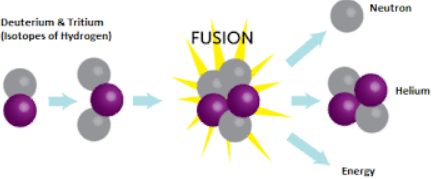Nuclear Fusion:
-
Nuclear Fusion is defined as the combining of two lighter nuclei into a heavier one.
-
Such nuclear fusion reactions are the source of energy in the Sun and other stars.

Significance of Nuclear Fusion:
-
Large source of power: A kilogram of fusion fuel contains about 10 million times as much energy as a kilogram of coal, oil or gas.
-
Low carbon: Given that it is not based on fossil fuels, the carbon emissions will be much lower.
-
Safety: Nuclear fusion is much safer as compared to nuclear fission reactors.
-
No Radiations: Fusion causes no poisonous radiation.
-
No Pollution: There are no emissions of carbon compounds, or any other pollutants.
Challenges:
-
Triggering fusion reactions requires temperatures of 100 million degrees Celsius, and pressures of 100 billion Earth atmospheres.
-
Currently nuclear fusion process is triggered by nuclear fission process. However, this process is very destructive, as the fission explosion also releases lethal radiation that may last for millennia.
-
A more usable form of fusion would require a less destructive trigger, and it would release fusion energy in a controlled, usable format.
Available options:
-
Magnetic confinement designs/ Tokamak’s magnetic fields: It creates a very powerful magnetic field, which confines the fusion material. However, creating a Tokamak’s magnetic fields and sustaining it, or bombarding an inertial containment capsule, takes large amount of energies.
-
Inertial confinement: In this process, fusion material is stored inside a physical capsule, which is squeezed.
Global efforts:
-
Thirty-five countries, including India, Russia, the United States, the United Kingdom, China, European Union, are collaborating to jointly build the largest Tokamak as part of the International Thermonuclear Experimental Reactor (ITER) in southern France.
-
Energy production is planned to be commenced from 2035.
Efforts in India:
-
The Institute for Plasma Research (IPR) in Gandhinagar and the Hot Plasma Project at Saha Institute of Nuclear Physics (SINP), Kolkata are leading nuclear fusion research in India.